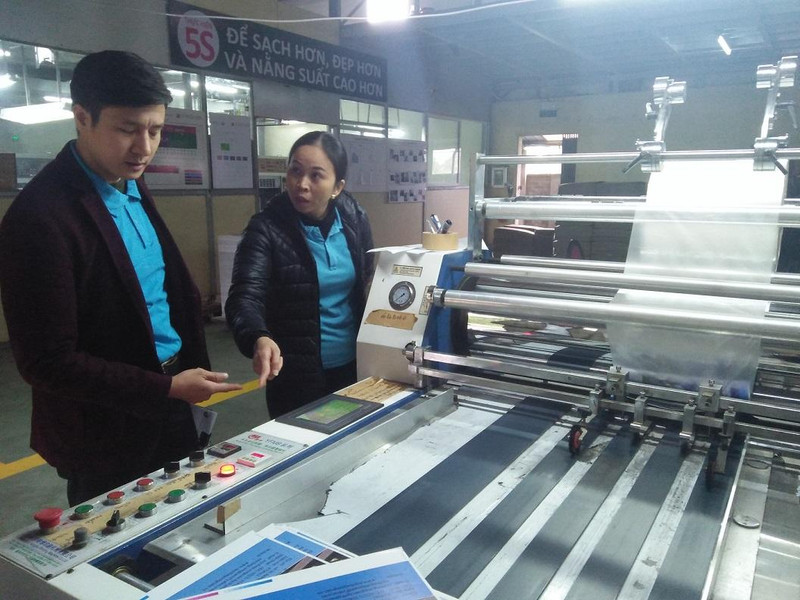It has been scheduled that on November 10, the National Assembly (NA) will officially vote for the approval of a resolution on national socio-economic development for next year, with concrete goals (see box for details) – one of which is a growth rate of 6.5%, much lower than an expected rate of about 8% for 2022. The resolution is prepared by the government as under the current regulations.
Like many NA deputies, Hoang Van Cuong representing Hanoi agreed on the government’s proposal on a 6.5% economic growth rate for next year which he said is quite suitable and even relatively high due to a series of risks affecting the domestic economy.
“Next year, it is expected that the world economy will continue facing big challenges with possible high inflation and a recession. A danger of a global economic crisis will become increasingly serious due to impacts of both wars and pandemics,” said Cuong, who is an economic expert. “Meanwhile, Vietnam’s economy is quite open to the global economy, so it will get easily vulnerable to any external shocks. How Vietnam can weather the global crisis will be very difficult, and an answer must be found out.”
According to the General Statistics Office (GSO), Vietnam’s total export-import turnover last year was 668.54 billion USD, or 1.81 times higher than GDP of 368.68 billion USD. Total export-import revenue hit 336.31 billion USD and 332.23 billion USD, up 19 and 26.5% year-on-year, respectively.
Cuong added that after two years of COVID-19, Vietnamese enterprises in general are bearing big debts, while in 2023, the time for fiscal policies to support enterprises will end and enterprises will have to fully perform their existing financial obligations and pay debts that they have been delayed in payment.
“These financial burdens may quickly drive businesses into bankruptcy. Thus schemes on further assisting them must be devised, especially in the event that an economic crisis happens,” Cuong suggested.
Needing bigger support
Echoing this view, NA deputy Nguyen Nhu So from Bac Ninh province, also suggested that the legislature and the government needs to formulate more solutions to assist enterprises from now until 2023, as many of which are facing numerous difficulties, and this will help the economy grow 6.5% next year.
According to the GSO, in the 10 months of 2022, the number of businesses suspending business for a definite time is 66,400 - up 36.9% year-on-year; 40,300 enterprises stopped operations and waited for dissolution procedures - up 15.2%; 15,400 businesses completed dissolution procedures - up 13.4%. On average, 12,200 businesses withdraw from the market every month.
“Thus enterprises would need urgent support. It is necessary to focus a priority on removing institutional obstructions, especially the operation of the public sector and asset rights including intellectual property rights (IPR) and administrative quality, in order to improve the economy’s competitiveness and increase the confidence of the public and businesses,” So said. “It is also necessary to change the mindset of institutional reform in a manner in which enterprises are considered as a partner instead of as a managed entity. Also, enterprises’ assets and IPR must be protected as no investors want to invest into places where their assets and IPR fail to be protected.”
Meanwhile, many NA deputies like Nguyen Minh Tam from Quang Binh province underscored the imperative need for the government to accelerate the deployment of Decree No.31/2022/ND-CP on interest rate support from the state budget for loans of enterprises, cooperatives, and business households. According to Decree 31, these entities are entitled to enjoy a 2% rate of interest subsidies for their loans.
“However, over the past four months of deployment, total loans provided hit a very low level with several customers, including one customer in Quang Binh with a loan of 500 million VND (21,740 USD),” Tam said. “This figure is too small as compared to our expectation from the resolution.”
Statistics show that this 2% lending rate support package implemented via the commercial bank system has seen a very low disbursement rate – at only 13.5 billion USD (nearly 587,000 USD) out of 16.03 trillion VND (696.96 million USD) allocated to 2022. The total value of this package is 40 trillion VND (1.74 billion USD) for 2022-2023.
“Many reasons can be cited for such slow disbursement. One of which there is a condition that in order to obtain such 2% support, the customer is required to demonstrate its recovery capacity, which remains relative vague,” said NA deputy Nguyen Hai Dung from Nam Dinh province. “Many customers said they can pay debts but cannot affirm that they have an ability of recovery, especially in the context that there has been a rise in production costs and USD, and uncertainties in the global market. Thus, this requirement needs to be removed as soon as possible to make it easy for enterprises to access the incentive.”
International projections
The Asian Development Bank (ADB) has forecasted that the Vietnamese economy may grow to expand 6.5% in 2022 and 6.7% in 2023.
“The global economic slowdown could weigh on exports. A labour shortage is expected to impede the fast recovery of services and the labor-intensive export sector in 2022. The slow delivery of planned public investment and social spending, especially the implementation of the government’s Economic Recovery and Development Programme, could slow growth this year and the next,” Andrew Jeffries, ADB country director for Vietnam, told VIR.
He added that in 2023, a continued economic decline in the global market will likely affect Vietnam’s exports which are one of the key growth impetus of the country.
However, the ADB in this December will announce an update on Vietnam’s economic growth outlook for the whole 2022 and 2023.
“We see lots of risks, but the biggest risk will still come from outside, meaning external shocks may continue affecting the Vietnamese economy,” Nguyen Minh Cuong, principal country economist at the ADB, said. “However, the ADB has a big confidence on Vietnam’s growth potential in the middle and long term. In fact, the confidence of investors and people are increasing strongly and this is a very important impetus for the economy. Besides that Vietnam’s exports have also risen significantly.”
In this first 10 months of this year, Vietnam’s total export turnover is estimated to be 312.82 billion USD – up nearly 16% year-on-year, the GSO reported.
Data released on September 29 showed that Vietnam’s real GDP growth accelerated sharply from 7.8% on-year in Q2 to 13.7% year-on-year in Q3. That marked the fastest pace of growth in more than a decade and brought year-to-date growth to 8.83% year-on-year. The recovery so far this year has been supported by an easing of COVID restrictions, accommodative policy settings, and resilient exports.
However, Fitch Solutions commented, “These factors will not be sustained. While we now believe that the economy is on course to achieve growth of 7.8% in 2022, a sharp slowdown to 6.5% in 2023 looks likely.”
According to Fitch Solutions, the boost from looser containment measures will be short-lived though, and aggregate GDP growth is probably now already past the peak. “Furthermore, with domestic monetary tightening now underway and the outlook for global demand worsening, we think that the Vietnamese economy is set to slow steadily into 2023.”
“The lagging impact of monetary tightening will be compounded by a deteriorating external backdrop. Vietnam’s export-oriented economy will feel the pinch from a sharp slowdown in the global economy next year. Factoring in the effects of tightening credit conditions around the world, our global team forecasts global output to rise by just 2.1% in 2023, below the International Monetary Fund’s latest downwardly-revised 2023 forecast of 2.7%,” Fitch Solutions said. “We also now expect the US to enter a mild recession in late 2023, which would bode poorly for Vietnam’s exports. Shipments to the US typically account for roughly 30% of Vietnam’s total merchandise exports, and have been a key source of external support since the pandemic started. But they have dropped in recent months, and are likely to fall further still.”
Box 1: Estimation for Vietnam’s socioeconomic performance in 2023
Source: Ministry of Planning and Investment
| Index | Unit | Goal for 2023 | |
| 1 | GDP growth | % | 6.5 |
| 2 | Per capita | USD | 4,400 |
| 3 | Ratio of manufacturing and processing in GDP | % | 25.4 – 25.8 |
| 4 | Average consumer price index | % | 4.5 |
| 5 | Increase of labour productivity | % | 5-6 |
| 6 | Ratio of agricultural labourers in the economy’s total labourer number | % | 26.2 |
| 7 | Trained labourers | % | 68 |
| - In which labourers with diplomas and certificates | 27.5 | ||
| 8 | Unemployment in urban areas | % | Under 4 |
| 9 | Reduction of poverty rate under the multidimensional poverty index | Percentage | 1-1.5 |
| 10 | Number of doctors per 10,000 people | Doctors | 12 |
| 11 | Number of hospital beds per 10,000 people | Beds | 32 |
| 12 | Population with health insurance | % | 93.2 |
| 13 | Number of communes meeting standards of new rural areas | % | 78 |
| 14 | Collection and treatment of urban solid waste from households meeting standards | % | 94.71 |
| 15 | Operational industrial parks and export processing zones having concentrated wastewater treatment facilities that meet environmental standards | % | 91 |
















